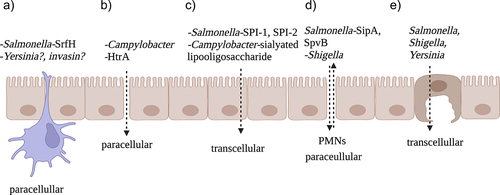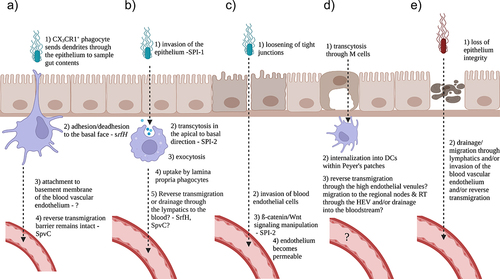Figures & data
Figure 1. Strategies used by four enteropathogens to breach the gastrointestinal epithelium. A) Salmonella and likely Yersinia can traverse the physical barrier within CX3CR1+ phagocytes that send dendrites through the paracellular space without disrupting the tight junctions. SrfH seems to regulate this process and Yersinia may require invasin for it to be efficiently utilized. B) Campylobacter cleaves E-cadherin, occludin and claudin-8 with HtrA to destabilize tight junctions and pass in between epithelial cells. C) Salmonella and Campylobacter can also pass through enterocytes. Salmonella requires both SPI-1 and SPI-2 effectors for this while Campylobacter enhances it with sialylated lipooligosaccharide cell structures. D) Salmonella and Shigella can recruit polymorphonuclear neutrophils to migrate through the paracellular space to gain access to the submucosa independently of the M cells. E) Finally, Salmonella, Shigella and Yersinia can pass through the M cells. This figure was generated with Biorender.

Figure 2. Pathways for Salmonella and likely other gut pathogens to spread systemically. A) Reverse transmigration. Infected phagocytes traverse the blood vascular endothelium in the basal to apical direction following uptake of gut bacteria. The tight junctions of the epithelium and the endothelium remain intact. B) Salmonella can pass through the epithelial cells and may be able to trigger lamina propria phagocytes to reverse transmigrate or alternatively drain through the lymphatics to the blood. C) Salmonella can invade the endothelium and manipulate ß-catenin/Wnt signaling, rendering the blood vessels permeable. D) Salmonella can pass through the M cells and drain through the lymphatics to the blood or perhaps trigger the reverse transmigration of infected phagocytes through the high endothelial venules associated with the Peyer’s patches and/or mesenteric lymph nodes. E) S. Typhi rapidly destroys epithelial cells and then drains through the lymphatics to the blood and/or triggers the reverse transmigration of infected phagocytes. This illustration was generated with Biorender.

Table 1. Major pro-inflammatory effectors.
Table 2. Major anti-inflammatory effectors.
